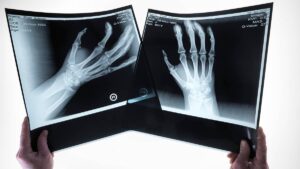ScoPo’s Powerplays: ASX health stocks fall in ‘lacklustre’ week

Pic: Getty Images
- ASX health stocks dropped 1.22% in the past four days, while the broader markets fell 1.35%
- Morgans downgrades Ramsay Health Care following its FY24 results, believes a ‘near-term earnings recovery looks challenging’
- Percheron reports positive preclinical data for its ATL1102 in a mouse model of autoimmune epilepsy
Healthcare and life sciences expert Scott Power, who has been a senior analyst with Morgans Financial for 26 years, explains what the movers and shakers have been doing in health and gives his ASX Powerplay.
Australia has a long history of medical research and innovation with health science research in Australia ranked seventh globally. As part of our weekly ScoPo column we’ve decided to showcase groundbreaking Aussie medical research.
An Opioid Safety Toolkit has been launched this week to empower Australians with the knowledge and resources for safer prescription opioid use, including common painkillers like codeine and oxycodone.
Opioids are the leading cause of overdose deaths in Australia, claiming more than 1,000 lives each year. Since 2006, unintentional opioid-related deaths have nearly tripled, mostly involving prescription opioids rather than heroin.
Naloxone, a life-saving medication that reverses opioid overdoses by blocking their effects in the brain, is only present in 2% of households where opioids are prescribed.
Developed in partnership between Monash University, Painaustralia and the Pharmaceutical Society of Australia, with funding from the Federal Government, the toolkit has been co-designed with consumers and a range of health professionals.
The public launch coincides with International Pain Awareness Month in September. According to PBS data, around 13.3m opioid scripts were dispensed to nearly 3 million Australians for pain relief in 2021-2022.
Monash University lead investigator Professor Suzanne Nielsen said the Toolkit was backed by more than a decade of research and would promote best evidence-based practices in opioid safety.
“Through our own research over the past decade, we identified a significant gap in opioid safety,” she said.
“Existing resources around naloxone were primarily targeted at people who use illicit drugs, yet it is a really useful safety measure to have in the home for people using opioids for any length of time,” said Professor Nielsen.
Painaustralia CEO Giulia Jones said the Toolkit could benefit millions of Australians.
“We could see Naloxone offered at the point of prescription, to have in the home for any accidental use and to keep people who have opioids for managing pain as safe as possible,” Ms Jones said.
“We have a high respect for the 3.4 million people living the best that they can despite chronic pain, and we want them to have all the tools they need to live well and to get the most out of life, and safety is a part of that.”
Since 2022, all Australian community pharmacies have been eligible to supply naloxone to individuals at risk of experiencing opioid overdose for free with no prescription through the national Take Home Naloxone program.
However, recent research found almost 40% of community pharmacies across four of Australia’s most populous states do not stock naloxone.
The Toolkit can be accessed at www.saferopioiduse.com.au and will also be disseminated via Australian community pharmacies.
To markets…
And ASX healthcare stocks are feeling a bit of pain for the first week of September. At close on Thursday the S&P/ASX 200 Healthcare index (ASX:XHJ) was down 1.22% for the past four days, while the benchmark S&P/ASX 200 (ASX:XJO) fell 1.35% for the same period.
The Index fell 1.04% in August but at the end of the month was up ~9% YTD, according to data from S&P Dow Jones Indices (S&P DJI).
“It’s been another lacklustre week,” Power said.
“We are really just waiting for interest rate cuts in the US with an announcement due in late September.”
“If that happens hopefully that will spark some interest back in the growth part of the market.”
Morgans downgrades Ramsay
Morgans has downgraded Australia’s largest private hospital operator Ramsay Health Care (ASX:RHC) to a hold and reduced its 12-month share price target from $56.54 to $44.77.
RHC fell ~7% last Friday after releasing its full-year results, which were largely in line with forecasts.
RHC recorded a net profit of $888.7m, up from $298.1m a year earlier, which included the $618m sale of its stake in Ramsay Sime Darby (RSD), which owns hospitals in Malaysia and Indonesia.
In a note to clients Morgans’ analyst Derek Jellinek said that FY24 underlying results were above the top end of updated guidance, driven by low single digit admissions growth across key geographies, tariff and indexation gains, but supported by lower tax and minority interest as operating profit was soft.
“Earnings grew in Australia and UK, with a turnaround in Elysium, but were partially offset by ongoing inflationary pressures in the EU,” Jellinek said.
In FY22 RHC acquired Elysium Healthcare, which it described as an independent provider of specialist health and care services which were commissioned by the NHS and local government authorities across England and Wales.
Elysium focuses on mental health and wellbeing, learning disabilities and autism, neurological, and children and education.
“While ongoing activity is encouraging, it is slowing, and when coupled with the lack of any noticeable progress on the strategic review and H2 weakness on additional headwinds and uncertainties, a near-term earnings recovery looks challenging,” Jellinek said.
IMEXHS margin traction on cusp, but not yet
Considered a ‘mini me’ of both Mach7 Technologies (ASX:M7T) and ProMedicus (ASX:PME), Colombian-based medical imaging software and radiology services company Imexhs (ASX:IME) released its H1 FY24 results with EBITDA in line with expectations.
A while back, Stockhead’s Tim Boreham said “most folk confuse the company with either INXS or Imax cinemas”, but it provides similar imaging tools to PME and M7T.
In a note to clients, Morgans’ analyst Iain Wilkie said FY24 EBITDA guidance was adjusted toward lower end of range with forward investments in product and support “likely a short-term drag”.
“Free cashflow continues to oscillate around the breakeven mark paired with low cash buffers, but the opportunity to break out is only a handful of meaningful contracts away,” he said.
“ARR growth is solid, but weighted heavily toward the low/no margin services division.
“Investors continue to wait on better traction in software contracts.”
Morgans has reduced its 12-month target price to $1.15 from $1.50 and maintains a speculative buy recommendation on IME.
“They’re just taking a bit longer to hit their straps but still heading in the right direction,” Power remarked.
Positive results for Percheron
Power considers that one of the more interesting plays in the ASX healthcare sector at the moment is Percheron Therapeutics (ASX:PER) (formerly called Antisense Therapeutics), which is focused on treatments for rare diseases including Duchenne muscular dystrophy (DMD).
PER this week announced new preclinical data for its lead program, avicursen (ATL1102), in a mouse model of autoimmune epilepsy, which the company said provided further validation for its pharmacological activity as an anti-inflammatory agent and suggested a new group of patients who may benefit from the drug in the future.
Avicursen is an antisense oligonucleotide targeting CD49d, a receptor involved in white blood cell activity and has shown effectiveness in multiple inflammatory conditions, including multiple sclerosis and (DMD).
“PER’s major focus current sits squarely in DMD, with the major Phase 2b trial ongoing, with topline results expected in December 2024,” Wilkie said in a note clients.
Furthermore, PER recently reported its FY24 results, which Wilkie wrote provided no surprises given quarterly updates.
Wilkie said the cash balance remained the major key metric, sufficient to fund PER beyond the Phase 2b topline outcome in December.
He wrote the focus remains solely on PER’s near-term catalysts including a toxicology study and Phase 2b top-line results.
“We expect the monkey toxicology data to show the drug is generally safe and unlikely to yield any material curve-balls.
“Management commentary suggests the data they’ve been getting shows a safety profile consistent with prior studies.”
PER said the nine-month toxicology study was a key regulatory requirement to enable future clinical trials and commercialisation in the US.
With more certainty around timelines, Morgans view potential for increased investor interest in PER in the lead-up to the topline readout.
“We view PER as having one of the best risk/return profiles in the space with clear near-term catalysts, strong board and management team, and scientific support for success,” Wilkie added.
Morgans maintains a speculative buy for PER and has upgraded its 12-month price target slightly from 23 to 24 cents.
ScoPo’s Powerplays – Nanosonics
Disinfection device maker Nanosonics (ASX:NAN) is Power’s pick of the week, which he said was “looking really interesting”.
“Their share price in this market sell-off has really performed quite well,” he said.
“Their full year result, largely pre-released came in line with expectations and they’ve put out some guidance which we think looks very achievable.”
NAN reported sales revenue was up 2% to $170m, the company saw total installed base growth of 7% (2,340 units) to 34,790 units globally in FY24, while recurring revenue was up 9% to $121.8m.
“Revenue growth of 8-12%, OPEX growth of 6-10%, and gross margins between 77% and 79% we view as beatable or at least achievable,” Wilkie said in a note to clients.
“While we don’t anticipate management to hail victory at the first sign of improvement, we do expect gradual improvements to commentary and likely carries reasonable potential for upside surprise.”
Power said the other key catalyst for NAN was the expected US FDA approval for Coris, which was the company’s newest device intended for cleaning flexible probes commonly used in procedures such as colonoscopies, gastroscopies, enteroscopies, endoscopic ultrasounds and bronchoscopies.
NAN filed a de novo regulatory submission for Coris in April and is forecasting approval within about a year.
“The expectation is it will get approved before April next year and that will be a real kicker for them and so I think it is one worth keeping in front of investors,” he said.
Morgans maintains an add rating on NAN and 12-month target price of $3.75.
Power said he was also looking forward to the upcoming HealthInvest 2024 conference on September 18 in Sydney, which was being hosted by Morgans in conjunction with Stockhead and the IR Department.
The event is set to highlight five of the ASX’s leading up-and-coming health and life sciences companies with presentations from ImpediMed (ASX:IPD) Percheon, Imricor Medical Systems (ASX:IMR), Race Oncology (ASX:RAC) and Clarity Pharmaceuticals (ASX:CU6).
“That will be a very interesting evening for investors to come along and listen to presentations from those five companies,” he said.
To register for the event go to www.healthinvestlive.com
The views, information, or opinions expressed in the interview in this article are solely those of the interviewee and do not represent the views of Stockhead. Stockhead has not provided, endorsed or otherwise assumed responsibility for any financial product advice contained in this article.
Disclosure: The journalist held shares in Mach 7 at the time of writing this article.

UNLOCK INSIGHTS
Discover the untold stories of emerging ASX stocks.
Daily news and expert analysis, it's free to subscribe.
By proceeding, you confirm you understand that we handle personal information in accordance with our Privacy Policy.








